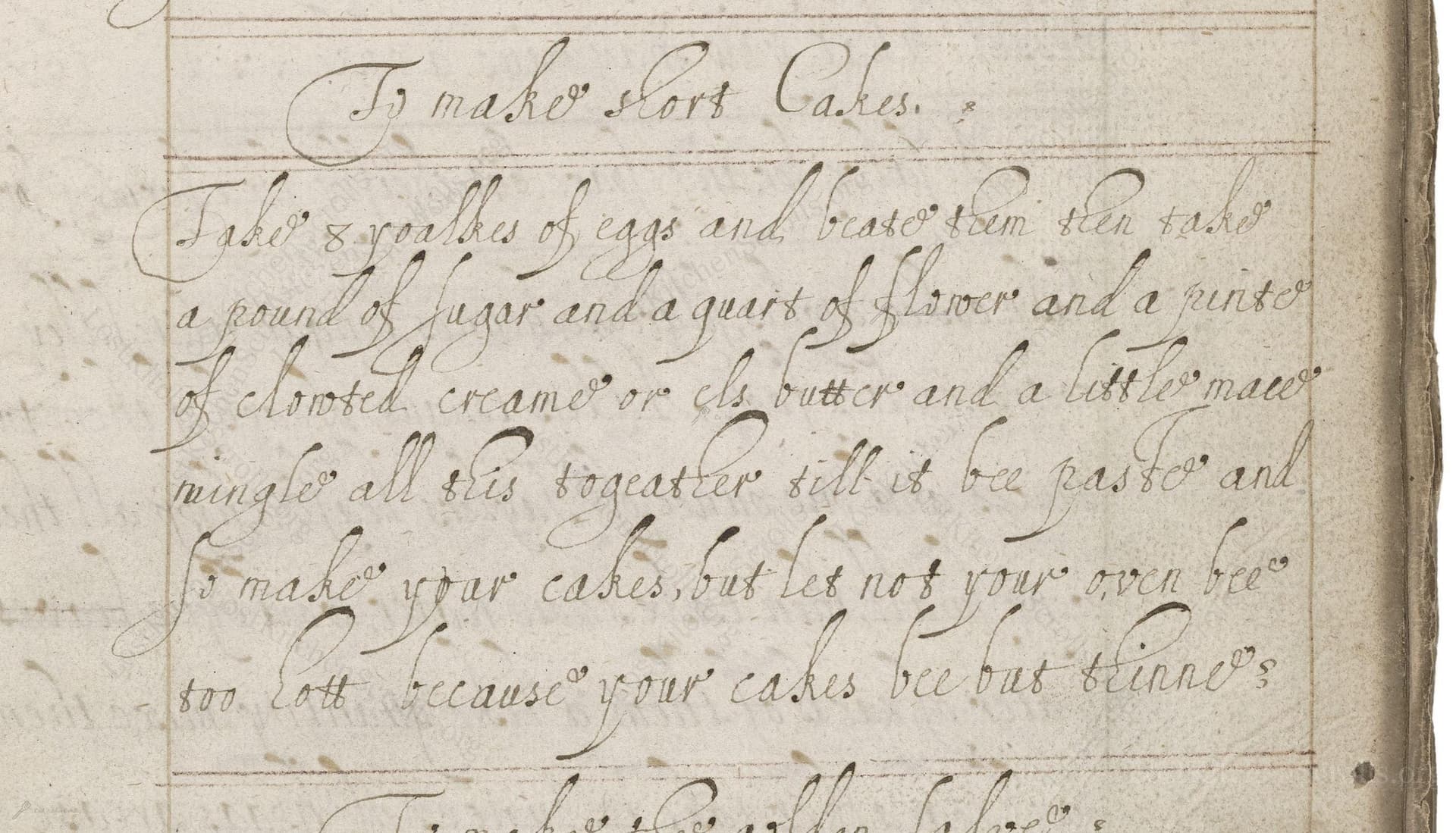To Make Short Cakes
From the treasured pages of Medicinal and cookery recipes by John King
Written by John King

To Make Short Cakes
"Take 8 yoalkes of eggs and beate them then take a pound of sugar and a quart of flower and a pinter of clowted creame or els butterr and a little mace mingle all this togeather till it be paste and so make your cakes but let not your oven bee too hott because your cakes bee but thinner."
Note on the Original Text
Recipes of this era are concise and assume a cook’s familiarity with basic baking methods, rarely providing detailed instructions or temperatures. Quantities are given in household measures—pounds, quarts, pints—and sometimes in approximate terms. Spelling reflects contemporary norms ('yoalkes' for yolks, 'clowted creame' for clotted cream, 'flower' for flour), and punctuation is sparse or absent. Instructions rely on sensory cues and personal judgement, trusting the reader’s intuition and experience in the kitchen.

Title
Medicinal and cookery recipes by John King (1675)
You can also click the book image above to peruse the original tome
Writer
John King
Era
1675
Publisher
Unknown
Background
A delightful journey into the kitchens of the 17th and early 18th centuries, this collection, attributed to John King, brims with time-honored recipes, culinary wisdom, and flavors that once graced historic tables.
Kindly made available by
Folger Shakespeare Library
This recipe for 'short cakes' comes from the English household manuscript V.a.490, attributed to John King (1696–1728), and dating from roughly 1625 to 1725—a period bustling with culinary innovation and the blossoming of refined baking. Short cakes were part of a broader family of rich, sweetened biscuit and cake recipes favored in English households. The use of egg yolks, sugar, and clotted cream or butter speaks to the wealthier end of the social spectrum, as these ingredients were expensive and highly valued. The addition of mace, a spice derived from nutmeg, further marks this as a luxury item for the historical table.

In the early modern English kitchen, cooks prepared doughs like this by hand, using wooden or earthenware bowls and large spoons. Eggs and sugar were beaten with a whisk or even bundled twigs. The dough would be shaped with knives, cutters, or simply rolled by hand. Baking took place in a brick or stone oven, heated with wood, with temperature judged by experience—often by observing how long you could hold your hand inside the oven. Flat baking stones or simple metal sheets acted as trays.
Prep Time
20 mins
Cook Time
25 mins
Servings
20
We've done our best to adapt this historical recipe for modern kitchens, but some details may still need refinement. We warmly welcome feedback from fellow cooks and culinary historians — your insights support the entire community!
Ingredients
- 8 egg yolks
- 1 pound (about 2 1/4 cups) granulated sugar
- 1 quart (about 4 cups) plain wheat flour
- 1 pint (2 cups) clotted cream (or substitute with unsalted butter, softened)
- 1/4 teaspoon ground mace
Instructions
- Begin by separating 8 egg yolks and whisking them until smooth.
- In a large bowl, combine 1 pound (about 2 1/4 cups) of granulated sugar with 1 quart (about 4 cups) of plain wheat flour.
- Next, add 1 pint (2 cups) of clotted cream—if clotted cream is unavailable, use unsalted butter at room temperature in the same amount.
- Incorporate a pinch (about 1/4 teaspoon) of ground mace.
- Mix these ingredients together to form a soft, cohesive dough.
- Roll or pat the dough out to about 1/4–1/2 inch thick and cut into rounds or shapes as desired.
- Lay the cakes on a baking tray lined with parchment.
- Bake in a moderate oven at 320°F (160°C) until lightly golden.
- Do not over-bake; these should remain pale and delicately tender.
- Let the cakes cool before serving.
- These 'short cakes' are rich, buttery, and gently spiced, ideal for afternoon tea or a historical treat.
Estimated Calories
230 per serving
Cooking Estimates
It takes about 20 minutes to prepare the dough and shape the short cakes. Baking takes another 20–25 minutes. Each cake contains about 230 calories, and this recipe makes about 20 cakes.
As noted above, we have made our best effort to translate and adapt this historical recipe for modern kitchens, taking into account ingredients nowadays, cooking techniques, measurements, and so on. However, historical recipes often contain assumptions that require interpretation.
We'd love for anyone to help improve these adaptations. Community contributions are highly welcome. If you have suggestions, corrections, or cooking tips based on your experience with this recipe, please share them below.
Join the Discussion
Rate This Recipe

Den Bockfisch In Einer Fleisch Suppen Zu Kochen
This recipe hails from a German manuscript cookbook compiled in 1696, a time whe...

Die Grieß Nudlen Zumachen
This recipe comes from a rather mysterious manuscript cookbook, penned anonymous...

Ein Boudain
This recipe comes from an anonymous German-language manuscript cookbook from 169...

Ein Gesaltzen Citroni
This recipe, dating from 1696, comes from an extensive anonymous German cookbook...
Browse our complete collection of time-honored recipes



